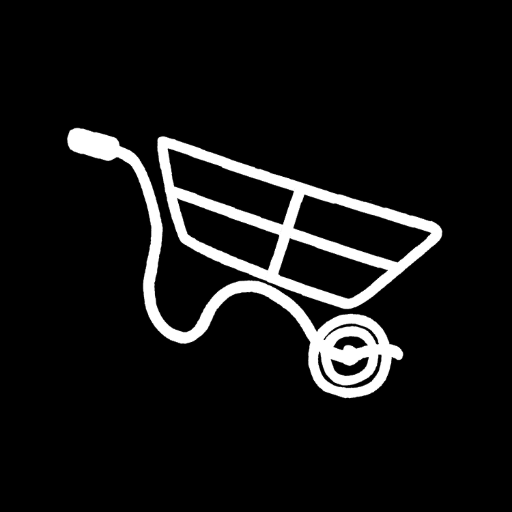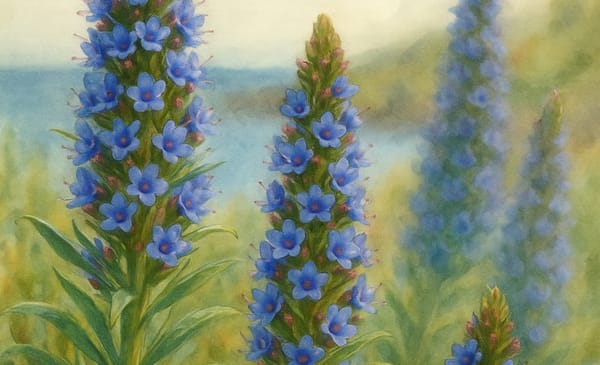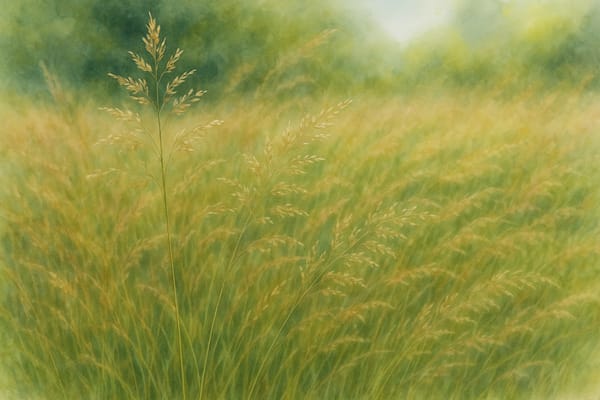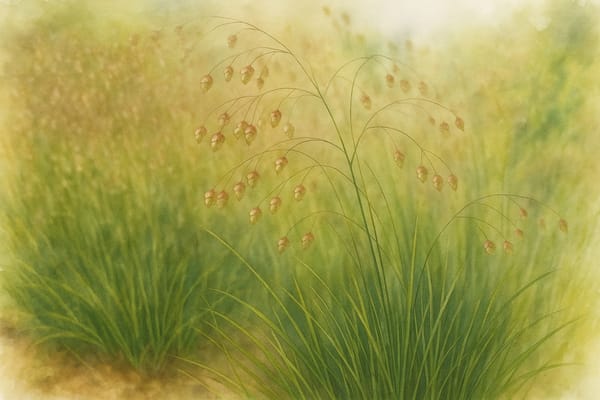Echium pininana, often called Tree Echium or Giant Viper’s Bugloss, is one of the most arresting plants in Cornwall’s coastal gardens. In bloom, its spires rise four metres or more, each one a vertical ribbon of blue-violet flowers buzzing with pollinators. With its palm-like rosette and dramatic stature, it delivers a subtropical flair to planting schemes, though it is not truly tropical.
From Volcanic Slopes to Cornish Shores
Echium pininana is native to the Canary Island of La Palma, where it grows on steep volcanic slopes and in laurel forest clearings. It is perfectly adapted to the island’s climate of dry summers and mild, wet winters, storing energy in a low rosette before sending up its single flowering spike. In its native range, it is listed as Critically Endangered by local conservation bodies, threatened by habitat loss, land-use change, and competition from invasive species.
Introduced to Britain in the 19th century, it quickly found favour in Cornwall, where the Gulf Stream tempers the climate. The earliest introductions are linked to Victorian-era plant collectors such as Sir Joseph Dalton Hooker, whose connections with botanical gardens encouraged the exchange of exotic species, and to estates like Tresco Abbey Garden and Tregothnan. Once established in estate gardens, its cultivation spread through seed sharing by Cornish horticultural societies and plant fairs, allowing it to take root in private gardens across the milder coastal districts.
- Trophy plant status: A prized exotic in Victorian collections.
- Exotic gardening movement: Featured alongside gunneras, palms, and other bold imports that define Cornwall’s subtropical style.
- Local tradition: Regularly seen in open garden events and plant fairs, often remarked upon in guided garden tours.
- Self-seeding success: In frost-free spots, seedlings appear unbidden in hedgerows, walls, and wild corners.
Although sometimes affectionately called a “wildflower” in Cornwall, it remains a non-native garden escape, with that term reflecting sentiment rather than strict taxonomy.
Why It Matters
| Aspect | Significance in Cornwall |
|---|
| Climate resilience | Thrives in frost-free valleys and coastal microclimates |
| Garden drama | Creates striking vertical structure |
| Biodiversity | Feeds bees, butterflies, and hoverflies for weeks |
| Garden identity | A hallmark of Cornwall’s exotic-style borders |
| Cultural emblem | Symbol of adventurous planting and global plant exchange |
Botanical Notes
Echium pininana is monocarpic, flowering once then dying, with a lifespan of two to three years. The narrow, silver-green leaves are rough with coarse hairs, forming a rosette up to a metre across. In its flowering year, the spike opens from base to tip over several weeks, most often in shades of blue-violet, though pink and white forms are occasionally seen in cultivation.
Growing Echium in Coastal Gardens
Ideal Conditions
| Requirement | Best Practice |
|---|
| Light | Full sun |
| Soil | Well-drained, moderately fertile |
| Shelter | Protection from strong winds and salt spray |
| Watering | Drought tolerant, avoid waterlogging |
| Feeding | Minimal; mulch in spring |
| Winter care | Fleece crowns or move pots under cover if frost threatens |
Season-by-Season Care
- Autumn: Protect rosettes with fleece or cloches; install windbreaks if exposed.
- Winter: Check fleece for damage, ensure soil drains freely to avoid crown rot.
- Spring: Mulch well, stake young flower stems before they gain height.
- Summer: Water during prolonged drought, deadhead if you wish to prevent self-seeding.
Additional Tips
- Staking: Tall spikes are vulnerable to gales; use discreet canes or supports in exposed gardens.
- Wildlife value: An exceptional nectar source during late spring and early summer.
- Toxicity: All parts contain pyrrolizidine alkaloids that can cause liver damage if ingested, especially in horses, with risks to dogs and cats. May cause mild skin irritation in sensitive individuals; wear gloves.
- Responsible growing: Remove unwanted seedlings in ecologically sensitive sites to prevent spread.
Traditional Cornish Know-How
- Mulching to conserve moisture and enrich the soil.
- Windbreak planting with hedges or walls for protection from salt winds.
- Self-sown advantage where in-place seedlings outperform transplants.
- Slug and snail protection for young rosettes in damp springs.
Notable Varieties
- Echium pininana (Tree Echium) – the iconic Cornish giant.
- Echium candicans (Pride of Madeira) – shorter, bushier, with striking violet-blue flowers.
- Echium vulgare (Viper’s Bugloss) – a UK native with folklore ties.
Where to See Them in Bloom
Best displays appear from late May to July, when the spikes are at their fullest. Notable locations include:
- The Lost Gardens of Heligan
- Tresco Abbey Garden (Isles of Scilly – naturalised and reliably frost-free)
- Trebah Garden
- Tremenheere Sculpture Gardens
- Coastal gardens in Penzance, Falmouth, and the Roseland Peninsula
Plant ID Note
In UK gardens, Echium pininana is sometimes confused with Echium simplex, another tall species from the Canary Islands with pure white blooms, or with cultivated hybrids between the two. While both share the same towering habit, flower colour and leaf form can differ, and hybrids may show intermediate traits.











